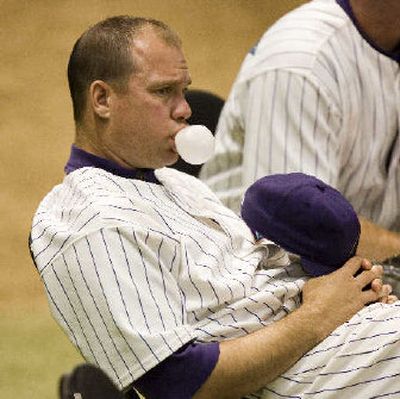A dubious choice

SAN FRANCISCO – The latest scandal to hit Major League Baseball involves a rarely prescribed drug called human growth hormone that doctors give to children who have trouble growing and adults with pituitary gland problems.
But it’s also peddled illegally to customers seeking to reverse the effects of aging and to athletes looking to boost performance and dodge detection of the drug because it can’t be found in widely used urine tests.
The revelation that Arizona Diamondbacks pitcher Jason Grimsley used human growth hormone, along with steroids and amphetamines, may have come as a surprise. The fact he was able to get it, however, was not surprising despite strict federal regulation.
There’s a robust black market for the rarely prescribed hormone thanks to an aggressive Internet and e-mail marketing campaign by dozens of companies around the world touting its alleged benefits in strength gains and reversing the aging process. Often, it only takes filling out a simple, online questionnaire and the customer’s assertion they have a prescription to get the drugs shipped.
Grimsley, who was released by the team Wednesday after his house was searched a day earlier, said he began exclusively using growth hormone when baseball’s testing program began in 2003, according to an affidavit filed by federal investigators. He also identified several other players who used or supplied the drugs, though their names were blacked out of court documents.
The drug is hard to uncover in athletes because it is naturally released in spurts, it disappears from the body quickly, and its blood level varies widely depending on diet.
In baseball, it’s even harder to find because the league’s testing policy prevents drawing blood, which is the only way to detect it.
The legal uses are relatively rare occurrences and have to be specifically approved by the Health and Human Services secretary, who has not authorized its “use for anti-aging, bodybuilding, or athletic enhancement,” the Food and Drug Administration said in a statement. The hormone can cost a user as much as $20,000 a year.
Still, black-market demand for human growth hormone is strong and growing. It has become the illegal darling of anti-aging advocates and professional athletes looking to boost energy, increase strength and stave off the effects of getting old.
Barry Bonds and other star baseball players have already been implicated in an illegal drug ring that included growth hormone distribution based at the Burlingame, Calif.-based Bay Area Laboratory Co-Operative.
Five people connected to the lab have pleaded guilty to various charges and the same agents who led the Balco investigations also raided Grimsley’s house.
The FDA’s Office of Criminal Investigation had 55 criminal growth hormone cases in 2005 compared to fewer than 10 in 1995. The FDA has also sent “warning letters” to at least three companies since 2003 ordering them to stop marketing growth hormone as an anti-aging substance.
The hormone helps cells regenerate and adds up to four inches of growth to children who are legally prescribed it. But the drug’s beneficial effect on healthy people has been fiercely debated for the last 15 years and the federal government has approved its use only for rare, growth-related afflictions mostly in children and adults with pituitary gland tumors.
That hasn’t stopped the apparent widespread use among elite athletes and the proliferation of anti-aging clinics and Web sites touting fountain-of-youth properties.
“One of the hallmarks of quackery is trying to dupe the public with very simple messages,” said Dr. Thomas Perls, a Boston University aging specialist. “Growth hormone drops with aging, therefore they conclude growth hormone can prevent old age.”
Human growth hormone is produced in the pituitary gland, a pea-sized structure at the base of the brain that controls growth and other functions. In the mid-1980s, scientists at the biotechnology pioneer Genentech Inc. figured out how to produce the hormone by genetically engineering human genes into bacteria.
Since then, the reported global market for human growth hormone has reached nearly $1 billion annually with seven companies, including Eli Lilly & Co., Pfizer Inc. and Novartis, producing similar versions.
A small study in the New England Journal of Medicine in 1990 showed 12 men older than 61 who took growth hormone for six months increased muscle mass and decreased body fat. That study launched underground sales of the drug.
“Since then, a lot of studies have been done and the effect of growth hormone on older people is that there has been nonexistent or very modest benefits,” said Dr. Evan Hadley, of the National Institute on Aging. “For middle-age people the case is even weaker and riskier.”
Scientific studies have shown the hormone to have little effect on healthy people while others found benefits but significant side effects including elevated risks of diabetes, carpal tunnel syndrome and high blood pressure.